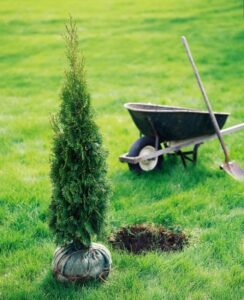The Proper Way to Plant a Tree

Once you understand the proper way to plant a tree, you’ll have your own in no time. Digging a wide planting hole is the key to fast growth of your new tree. Recommendations often specify a hole twice as wide as the root ball; three times as wide is even better. To prevent settling, the depth should be no more than the height of the root ball.
See directions on how to plant a tree step-by-step below, along with some helpful information to find out how much your tree is worth.
1. How to Dig a Hole for a Tree
First, prepare a hole two to three times as wide as the root ball of your tree. Handle the root ball carefully to keep it intact while you place it in the hole. Once it’s in, turn it so the best side of the tree is facing the direction you want. With burlapped root balls, cut the twine and remove the burlap (or at least push it to the bottom of the hole).
Plant small trees (that reach 30 feet tall or less) at least 10 feet from your home’s foundation and utility lines. Plant large trees (30 to 70 feet tall) at least 15 feet from foundations and lines; give 70-foot trees 20 feet of distance.

2. Backfill Soil into the Hole
Backfill around the root ball, lightly packing the soil as you go. Frequently check the trunk to ensure that it’s straight. Use leftover soil as a berm to create a watering well.
Amending backfill with organic matter is an old practice. However, several studies have shown that it produces little benefit (as long as the existing soil is of reasonable quality), so many experts no longer recommend it. The most important factor, by far, is loose soil that new roots can easily grow into. That’s why a large planting hole is so vital.
3. Install Tree Stakes
Drive the stake into the ground underneath and through the root ball. The stake should be tied loosely to the trunk; do not lash it too tight.
Large trees may need two or three stakes placed several feet from the trunk.

Watering a Newly Planted Tree
Water the tree soon after planting and every day for several weeks afterward. By that point, the roots will have begun to grow out into the surrounding soil, and you can begin to gradually reduce the frequency of watering. Fertilizer is of marginal benefit at planting time, and can even be harmful. Wait until the following year, then provide a moderate dose of fertilizer. A 3-inch layer of mulch around the base of the tree will keep weeds out and reduce water loss.
Newly planted trees should only be pruned to remove broken, dead, or diseased limbs. Otherwise, leave them be until after their first growing season.
Why Plant a Tree?
Planting a tree is one of the easiest ways to add value to your home. Planting trees in your yard brings other benefits too. Here’s why you should invest time and money in planting trees:
- Homeowners achieved a 109 percent return on landscaping dollars spent—higher than any other home improvement, according to a Michigan University study. Trees especially increase the property value of your home by 15 to 20 percent.
- Strategically placed trees create shade and help save up to 56 percent on annual air-conditioning costs. Trees such as evergreens, placed appropriately around the house, can reduce the need for heating by 20 to 50 percent in winter.
- Trees increase curb appeal. Buyers are willing to spend 3 to 7 percent more on homes with ample trees rather than few or no trees. The presence of street trees also reduces time on the market by an average of 1.7 days.
- Trees also clean the air we breathe, decrease air pollution, support wildlife, slow stormwater runoff, conserve rainwater, buffer noise pollution, and bolster people’s health.

How to Choose the Right Tree
Start by looking around the neighborhood. Make a list of trees that appeal to you through the seasons and which ones appear to flourish. Visit local parks and arboretums to see native trees that have already adapted to your region and tend to succeed. A local arborist and county extension service can also identify the best trees for your landscape.
When buying a new tree, go for sturdiness over speed. A fast-growing shade tree may grow large quickly enough to provide ample privacy and beauty, but after 20 to 30 years, it will likely decline and become messy, susceptible to storm damage and require extra maintenance. Slow-growing, hardy species may offer the longevity and adaptability to your site that is most desirable.
Do your research before selecting a variety. Visualize the tree’s mature size and shape and how it would fit in with your landscaping. Investigate and verify the information on a plant tag with at least three other sources. Large trees work best in spacious yards as background specimens or for framing the house. Small trees suit smaller lots, of course. They stand out near driveways and walkways or create a pretty understory for larger trees.
After selecting a tree, protect your investment with careful upkeep. For its first two years, water a new tree weekly if nature doesn’t take care of it. Trees benefit from regular pruning—they will be healthier and more attractive. Remove any dead, damaged, or diseased branches each year. Consult an arborist with any questions.
Website: www.bhg.com

